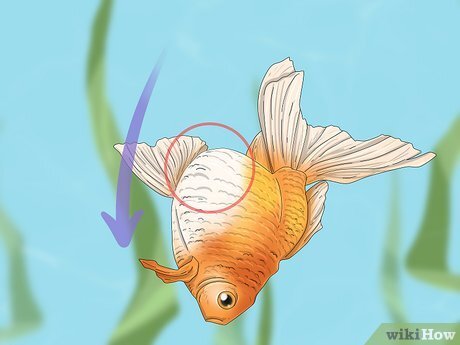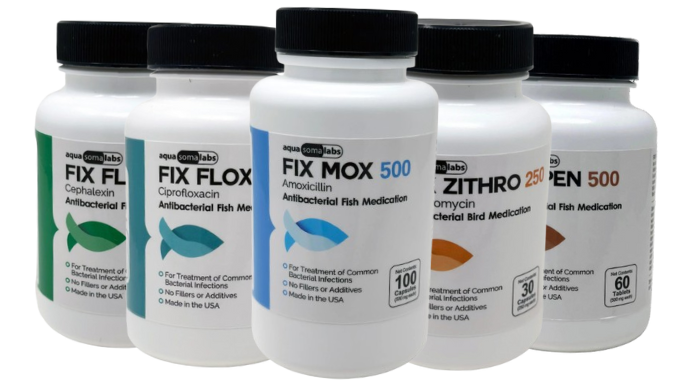Posted by Aquatic Veterinary Specialist on 6th May 2025
Swim Bladder Disease in Fish: Symptoms, Causes & Treatment
Swim Bladder Disease in Fish: Causes, Symptoms, and Treatment
Swim bladder disease in fish is a common and potentially serious condition that affects a fish’s buoyancy and ability to swim properly. Also known as swim bladder disorder or flipover disease, this ailment involves an issue with the fish’s swim bladder – the internal gas-filled organ that lets fish control their buoyancy. When the swim bladder isn’t working right, the fish can’t maintain its balance in water. You might notice your fish floating upside down, sinking to the bottom, or otherwise can’t swim properly. In this comprehensive guide, we’ll explain what swim bladder disease is, its causes and symptoms, and how to treat swim bladder disease. We’ll also cover effective treatments (from fasting to antibiotics) and professional tips for prevention to keep your aquatic pets healthy.
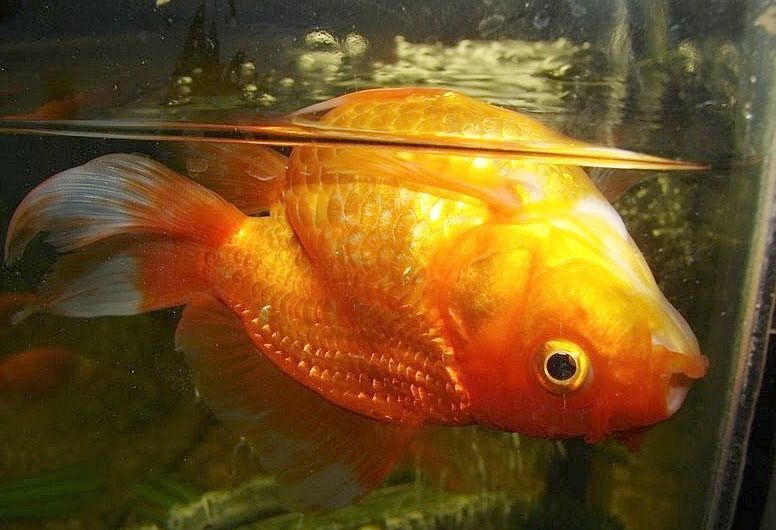
A fancy goldfish (ryukin) with swim bladder disease floating upside down at the water surface. Swim bladder dysfunction affects buoyancy, causing fish to lose equilibrium and swim abnormally.
What Is Swim Bladder Disease?
The swim bladder is a balloon-like internal organ filled with gas that helps fish control their buoyancy. By adjusting gas volume in this bladder, a fish can effortlessly hover at different water depths without constantly swimming. When this organ functions normally, the fish stays upright and balanced in the water. However, swim bladder disease refers to any dysfunction or disorder of this organ that hinders its normal operation. A fish with swim bladder disease cannot regulate its buoyancy properly, leading to balance problems and erratic swimming behavior. Affected fish often tilt to one side, float head-up or tail-up, or end up stuck either at the surface or on the tank bottom. While not a specific pathogen-caused illness, swim bladder disorder is a syndrome resulting from various underlying issues that disturb the swim bladder’s function. It is frequently seen in aquarium species like goldfish and bettas (especially fancy varieties) due to their anatomy, but it can impact any fish. If left untreated, severe swim bladder problems can greatly stress the fish, hinder feeding, and even be life-threatening. Understanding this condition is the first step to helping your fish regain its ability to swim normally.
Causes of Swim Bladder Issues in Fish
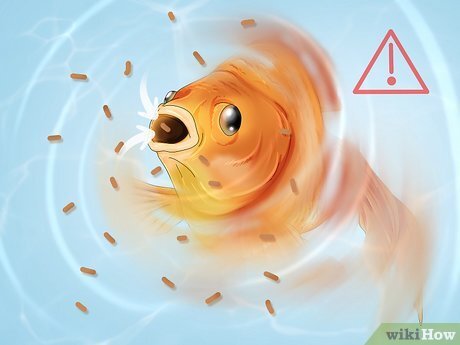
Swim bladder disease can have multiple causes, ranging from simple dietary problems to infections or anatomical defects. Identifying the cause is important for effective treatment. Here are the most common causes of swim bladder issues in fish:
-
Overfeeding and Constipation: One of the leading causes is overeating or ingesting air while feeding. When a fish eats too much (especially dry foods that expand in the gut) or swallows air at the water surface, it can lead to constipation or an enlarged stomach. The swollen stomach/intestines can press against the swim bladder, causing buoyancy problems. Constipated fish often develop a distended belly and may float abnormally as the trapped air/gas affects the swim bladder’s position.
-
Poor Diet or Gulping Air: A diet low in fiber or feeding methods that cause gulping air can trigger constipation and swim bladder trouble. Fish that feed rapidly at the surface on floating pellets or flakes might take in excess air. Dry flake or freeze-dried foods can also expand in the fish’s stomach. All these factors contribute to digestive bloating that impacts the swim bladder.
-
Bacterial or Parasitic Infection: Infection is another major cause. A bacterial infection (or less commonly, internal parasites) can inflame or partially paralyze the swim bladder or the nerves controlling it. Such infections often enter through the gut or via poor water conditions. A fish with a swim bladder infection may show severe difficulty swimming, lethargy, or other signs of illness (like clamped fins or redness) in addition to buoyancy issues. In these cases, treating the infection with appropriate antibiotics (see the section on Fish Antibiotics for Swim Bladder Disease below) is necessary to resolve the buoyancy problem.
-
Physical Injury or Trauma: Physical damage can lead to swim bladder dysfunction. If a fish suffers a hard impact – for example, colliding with tank decorations, getting injured in a fight, or a fall/jolt during transport – the trauma can damage the swim bladder organ or associated muscles. Such fish may suddenly lose the ability to stay upright. In some instances, a spinal injury can also affect the swim bladder’s function since the organ is closely positioned to the spine.
-
Anatomical Deformities: Some fish are born with defects or develop anatomical issues that predispose them to swim bladder problems. For instance, fancy goldfish breeds (like fantails, orandas, and ryukins) have round, compact bodies that crowd their internal organs. This compressed body shape can lead to chronic swim bladder disorders or make them more susceptible to issues from minor digestive upsets. If a fish has a congenital swim bladder deformity, symptoms might appear at a young age and be recurrent.
-
Water Quality and High Nitrates: Poor water quality can indirectly cause swim bladder disease. Elevated nitrate levels from inadequate tank maintenance can contribute to constipation or make fish more vulnerable to infection. Additionally, toxins like ammonia or nitrite stress the fish and may lead to inflammation or dysfunction of internal organs. Keeping water clean is crucial because healthy water conditions support overall fish health and digestion.
-
Low Water Temperature: For tropical fish or even goldfish, low temperatures can slow down their metabolism and digestion. If water is too cold for the species, food may not be processed efficiently, leading to indigestion or constipation that affects the swim bladder. For example, goldfish kept in very cool water might experience sluggish digestion. Ensuring the tank is at an appropriate, steady temperature can help prevent such cases.
Often, multiple factors can combine – for instance, a constipated fish in dirty, cold water has a higher chance of developing a swim bladder disorder. By understanding these causes, fish keepers can better diagnose the issue and apply the right remedy.
Symptoms and Signs of Swim Bladder Disease
Fish with swim bladder disease display distinct symptoms related to buoyancy and swimming behavior. Watch for the following signs in your fish, as they indicate a possible swim bladder problem:
-
Buoyancy Problems: The fish is unable to maintain its normal position in the water. It may float involuntarily to the top or, conversely, sink to the bottom and have trouble rising. Some fish might float with part of their body sticking out of the water or lie on the substrate unable to lift off.
-
Abnormal Swimming Posture: Affected fish often swim at odd angles. They might tilt sideways, swim upside down or head-down/tail-up. You may see a fish floating belly-up or rolled over, especially when at rest. They can still be alive in this state – a classic hallmark of swim bladder disorder is a fish that is alive but upside-down or sideways.
-
Struggling to Stay Upright: The fish can’t swim properly or has to exert extra effort to remain balanced. You might notice excessive fin movement – the fish frantically waving pectoral fins or tail in an effort to correct its orientation. Despite these efforts, it may continue to wobble or list in the water.
-
Distended Belly or Curved Back: Often the fish’s belly looks swollen or bloated. A swollen abdomen could indicate constipation or infection causing fluid buildup, which in turn presses on the swim bladder. In some cases, the spine may appear curved or the fish’s back arches due to internal pressure or prolonged abnormal posture.
-
Difficulty Eating: Some fish with swim bladder disease maintain a normal appetite, but others may lose interest in food. If the fish is unable to swim to the food or its mouth is down on the substrate, it might not feed properly. You might see the fish try to eat but spit food out because it can’t maneuver well. Over time, lack of nutrition can weaken the fish further.
-
Lethargy or Stress: Besides buoyancy issues, the fish could show general signs of distress. Clamped fins, rapid gill movement (if stressed), or resting in one spot for long periods can occur. However, note that swim bladder disease primarily manifests as a physical inability to swim normally – the fish may otherwise seem alert and attempt to behave normally if not suffering an infection.
These symptoms can range from mild (occasional imbalance) to severe (constant upside-down floating). If you observe one or more of these signs, promptly take steps to diagnose and treat the fish, as prolonged inability to swim can lead to sores, starvation, or other health decline in the fish.
Treatment: How to Treat Swim Bladder Disease
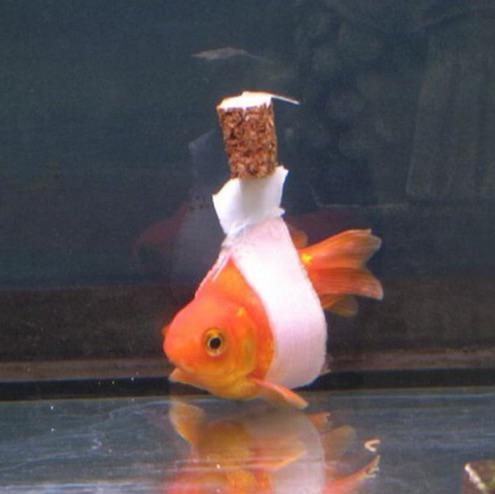
Treating swim bladder disease involves addressing the underlying cause and giving supportive care to help the fish regain normal buoyancy. In many cases, simple measures like dietary changes or water adjustments can fix the issue. In more serious cases, medication might be required. Follow this step-by-step treatment guide for swim bladder disorder:
-
Quarantine the Fish (Optional): If possible, move the affected fish to a hospital tank or separate container with clean, dechlorinated water. This makes it easier to treat and observe the fish, and ensures that tank mates won’t harass it while it’s vulnerable. (Swim bladder disease itself isn’t contagious, but isolation can reduce stress on the sick fish.) Keep the water shallow in the treatment tank so the fish doesn’t have to struggle to reach the surface.
-
Check Water Quality: Poor water conditions can be a contributing factor, so start by testing and improving the water. Test ammonia, nitrite, and nitrate levels and ensure they are in safe ranges (ammonia and nitrite 0 ppm, nitrates as low as possible, ideally under 20 ppm). Perform a partial water change (about 25-50%) to freshen the water. Also check the water temperature – if it’s below the ideal range for your fish, gradually raise it to the appropriate level. Warmer water within the species’ tolerated range (around 78°F/25°C for many tropical fish, or slightly higher than usual for goldfish up to ~75-80°F) can help boost metabolism and digestion.
-
Fasting (Stop Feeding): With many swim bladder cases, especially those caused by overeating or constipation, the first remedy is to withhold food for a short period. Do not feed the affected fish for at least 2-3 days. Giving the digestive system a rest can help clear any intestinal blockage or gas. Most healthy adult fish can easily handle a few days of fasting, and this alone often improves buoyancy if the problem was a too-full gut.
-
Adjust the Fish’s Diet: After a couple of days of fasting, if the fish’s condition is starting to improve (or even if it’s not yet), introduce a special easy-to-digest food to help clear the digestive tract. The most popular remedy is feeding a shelled pea. Take a frozen pea, thaw it (and optionally blanch it quickly), remove the outer skin, and offer the soft inner part of the pea to the fish. Peas are high in fiber and act as a natural laxative for fish, often relieving constipation within hours. Feed one pea and observe the fish – you can continue feeding a single pea once per day for a few days until the fish regains normal swimming. If peas are not readily accepted, other high-fiber foods or formulated swim bladder diets may be used. Avoid dry flakes or pellets during this time, especially floating types, as they can worsen gas buildup. Switch to sinking pellets or pre-soaked pellets when you resume regular feeding, to reduce the chance of gulping air.
-
Epsom Salt Bath: If the fish remains bloated or has trouble swimming, an Epsom salt treatment can help. Epsom salt (magnesium sulfate) acts as a mild muscle relaxant and can reduce swelling and constipation in fish. Prepare a separate container with tank water and dissolve 1 teaspoon of Epsom salt per gallon (or about 1 tablespoon per 3 gallons). Gently place the fish in this bath for 10-15 minutes, then return it to fresh water. This can be done once or twice a day for a couple of days. Alternatively, you can add a smaller dose of Epsom salt directly to the quarantine tank (for example, 1/8 teaspoon per 5 gallons) to have a continual gentle effect. Do not confuse Epsom salt with aquarium salt (sodium chloride) – for swim bladder issues, it’s the magnesium in Epsom salt that helps draw out fluid and ease constipation. Always dissolve the salt completely before exposing the fish, and never leave the fish unattended in a bath.
-
Maintain Optimal Environmental Conditions: Throughout treatment, make sure the fish’s environment is as stress-free as possible. Keep the water level low enough that the fish isn’t struggling to swim upward for air (especially for species like bettas that breathe at the surface). Reduce water flow if you have a strong filter current – too much water movement can exhaust a fish that is already having trouble swimming. You can also add a few drops of a stress-reducing conditioner (like those that promote slime coat health) to the water, which may help if the fish’s skin is exposed to air due to floating. Ensure good oxygenation with gentle aeration since the fish might be less able to move around. Dim the lights or provide a calm environment to minimize stress.
-
Observe and Give It Time: Many cases of swim bladder disorder will start to resolve with the above steps over a few days. Monitor the fish closely. If you see improvement (fish starting to level out, swim more normally, and regain appetite), continue with a careful feeding schedule and clean water until fully recovered. However, if there is no improvement after several days of fasting and peas, or if the fish’s condition worsens (e.g., signs of infection appear), then more intensive treatment may be needed.
-
Antibiotic Treatment (If Infection Suspected): If the swim bladder problem is caused by a bacterial infection – which might be the case if the fish is also showing illness symptoms like clamped fins, red streaks, or if there was no response to dietary fixes – you may need to treat with antibiotics. Look for signs such as persistent swelling that doesn’t go down, or if the fish had an injury or other infection signs. Using fish antibiotics for swim bladder infections can help clear the underlying issue. It’s often best to treat the fish in a separate hospital tank when using antibiotics. Be sure to remove any activated carbon from the filter (as it would absorb the medication). Follow the instructions on the antibiotic medication for dosage and duration – typically a course of treatment might last 5-10 days. (We will discuss specific aquarium antibiotics in the next section.) If you’re unsure, consulting a veterinarian who specializes in fish is advised, as they can recommend the appropriate antibiotic and confirm the diagnosis via examination or even X-ray.
Most importantly, be patient and don’t resort to drastic measures too soon. Many swim bladder cases, especially those due to overeating, can be cured with conservative treatment. However, if a fish does not recover after a couple of weeks of care, it may have an irreversible issue (like a tumor or congenital defect). In those rare instances, humane euthanasia might be considered to prevent prolonged suffering. Fortunately, the majority of buoyancy problems do improve with the right care.
Fish Antibiotics for Swim Bladder Disease (Bacterial Infections)
When a bacterial infection is believed to cause swim bladder disease, targeted treatment with antibiotics can be effective. There are several fish antibiotics available (without a prescription in many cases) that hobbyists can use to treat bacterial swim bladder infections or other internal infections in fish. These are essentially aquarium-formulated versions of antibiotics used in veterinary and human medicine. It’s crucial to use them responsibly: always follow recommended dosages, treat for the full course even if the fish appears better, and only use antibiotics when an infection is likely (unnecessary use can contribute to resistant bacteria).
Common fish antibiotics for swim bladder infections include:
-
Fish Amoxicillin – A broad-spectrum antibiotic in the penicillin family, often used for various bacterial fish diseases. It can help with swim bladder infections caused by susceptible bacteria and is popular because it’s effective and generally safe for most fish.
-
Fish Cephalexin – A cephalosporin antibiotic that targets a range of bacteria. It’s useful for treating Gram-positive bacterial infections in fish and can be an option if other meds fail or if suggested for certain pathogens.
-
Fish Penicillin – Penicillin-based antibiotics (like ampicillin) can treat some swim bladder infection cases, particularly those caused by Gram-positive bacteria. They are less commonly used than amoxicillin in fish but are available for specific needs.
-
Fish Ciprofloxacin – A fluoroquinolone antibiotic that is effective against many Gram-negative bacteria. If a swim bladder issue is due to an Aeromonas or Pseudomonas species (common in aquarium infections), ciprofloxacin might be recommended. It’s a powerful antibiotic, so ensure correct dosing.
-
Fish Metronidazole – An antibiotic effective against anaerobic bacteria and certain parasites. Metronidazole is often used in fish for internal protozoan infections (like Hexamita) and can help if the swim bladder problem is related to a protozoal infection or anaerobic bacterial infection in the gut.
-
Fish Clindamycin – An antibiotic that works well on Gram-positive bacteria and some anaerobes. Clindamycin might be chosen for infections where those types of bacteria are suspected.
-
Fish Azithromycin – A macrolide antibiotic that can treat a variety of bacterial infections in fish. It’s sometimes used for chronic infections or when other antibiotics can’t be used. Azithromycin has a longer half-life, so dosing might be less frequent.
-
Fish Doxycycline – A tetracycline-class antibiotic that is broad-spectrum. Doxycycline can be used for swim bladder infections and is known for treating both Gram-positive and some Gram-negative bacteria. It may be helpful in mixed or uncertain infection cases.
-
Fish Sulfamethoxazole – This is usually found in combination with trimethoprim (as SMZ-TMP) in fish antibiotics. It’s a broad antimicrobial that can treat a wide range of bacterial infections. Sulfamethoxazole/Trimethoprim is useful for resistant infections or where a broad approach is needed.
-
Fish Fluconazole – Fluconazole is actually an antifungal medication, not an antibiotic for bacteria. It’s included in aquarium treatments to address fungal infections. While fungal swim bladder infections are quite rare, fluconazole could be used if a fungal cause is identified (for example, a fungus infecting the swim bladder or internal cavity). In most swim bladder disease cases you won’t need this, but it’s good to be aware of in case of fungal issues.
When using any of these fish antibiotics, dose according to the package instructions (often dosing is based on per gallon of water or per 10 gallons, etc., for a certain number of days). Remove activated carbon from filters during treatment since carbon can absorb the medication. Keep up with water changes between doses if instructed, or after the treatment course, to remove any residual medication. Aerate the water well, as some antibiotics can reduce oxygen levels slightly. If possible, gradually warming the water can improve the medication’s effectiveness by increasing the fish’s metabolic rate (just ensure the temperature stays in a safe range).
Note: Antibiotic treatment should be reserved for cases where you strongly suspect a bacterial infection (or when simpler treatments haven’t helped). Misusing antibiotics can harm your fish’s beneficial bacteria and promote drug-resistant strains. If you’re not sure, consult with a veterinarian. Many fishkeepers, however, successfully treat swim bladder infections at home with these remedies, especially when veterinary access is limited. Always observe your fish’s response to the medication – if you see improvement (better posture, more activity) after a few days, continue the full course. If there’s no change, you might need to try a different medication or re-evaluate the diagnosis.
Prevention: Tips to Prevent Swim Bladder Disease
Preventing swim bladder disease is far better than dealing with it after it occurs. By taking proper care of your aquarium and fish’s diet, you can minimize the risk of buoyancy disorders. Here are some professional tips for preventing swim bladder issues in fish:
-
Feed Properly and Avoid Overfeeding: Overfeeding is a top cause of swim bladder problems, so be very mindful of how much and what you feed. Give your fish small, measured portions – only what they can consume in a minute or two, once or twice a day (depending on species needs). Use high-quality, varied foods that meet your fish’s nutritional requirements. Include fiber-rich options occasionally (such as a blanched pea or spirulina-based food) to promote healthy digestion. If your fish tends to gulp air at the surface when eating floating pellets or flakes, try soaking dry food before feeding or switch to sinking pellets. This reduces the air swallowed and also pre-expands the food outside the fish’s body. Remember to thaw frozen foods before feeding as well. A balanced diet in appropriate amounts will keep the digestive system working smoothly and prevent constipation.
-
Maintain Excellent Water Quality: Regular tank maintenance is crucial for overall fish health. Poor water quality can indirectly lead to swim bladder disease by causing stress, infection, or digestive issues. Perform regular partial water changes (e.g., 20-30% weekly or as needed based on water tests) to keep nitrate levels low. Use a good filtration system and clean the filter media as recommended (rinsing sponges, replacing carbon, etc., but not all at once to preserve beneficial bacteria). Monitor water parameters – ammonia and nitrite should always be 0; nitrates should ideally be under 20 ppm. Keep the substrate vacuumed to prevent waste buildup. Clean, stable water keeps your fish’s immune system strong and digestion normal, reducing the likelihood of swim bladder troubles.
-
Control Water Parameters and Temperature: Rapid changes or improper parameters can stress fish and predispose them to illness. Keep the water temperature steady and suitable for your species. If you have goldfish (which are cold-water fish), ensure the temperature isn’t too low (around 70°F is a good middle ground for fancy goldfish to aid digestion, even though they tolerate cooler water). For tropical fish, maintain their required range (often 75-80°F). Also maintain proper pH and hardness levels as needed by your fish type – while these might not directly cause swim bladder issues, overall comfort helps. Temperature in particular affects digestion, so a slightly warmer tank (within safe range) can prevent constipation. Always use a heater and thermometer (for tropicals or fancy goldfish) to avoid temp fluctuations, and have an air pump or sufficient surface agitation to ensure good oxygenation, especially at higher temps.
-
Minimize Stress and Injury: Stress can exacerbate any health issue. Provide a calm environment for your fish. Avoid rough handling or frequent netting of the fish. Ensure tank mates are compatible – aggressive interactions or fin nipping can harm or stress fish, potentially leading to injury or suppressed immunity (making infections more likely). If you have active decor or strong currents, ensure your fish aren’t getting slammed into objects or the tank walls. During maintenance, be gentle; sudden banging or drops can startle fish or in worst cases cause trauma. By reducing stressors – whether from aggressive tank mates, loud noises, or sudden changes in the environment – you help keep your fish’s overall health in check. A unstressed fish is less likely to develop the secondary issues that could lead to swim bladder disorder.
-
Consider Fish Breed Tendencies: If you keep species known for swim bladder issues (like fancy goldfish or betta splendens), take extra precautions. For example, fancy goldfish do best with slightly lower water depth and avoiding floating foods, as their body shape makes them prone to buoyancy problems. Betta fish, which often get swim bladder issues from gulping air or overeating, should be fed a varied diet (including the occasional fasting day) and not kept in water that is too cold. Research the specific needs of your fish breed and tailor your care routine to preempt problems.
By following these preventive measures – feeding wisely, keeping the aquarium clean and well-maintained, and minimizing stress – you will greatly reduce the chances of swim bladder disease affecting your fish. Healthy habitat and habits are the best defense. Most importantly, observe your fish regularly. Early signs of buoyancy trouble can be corrected more easily, so catching a problem before it becomes severe is key.
Final Thoughts
Swim bladder disease in fish can be alarming, but with prompt and proper care, most fish can recover and return to normal swimming. The keys are to ensure good water quality, provide a correct diet (and avoid overfeeding), and administer appropriate treatments like fasting, peas, or medications when needed. Always tailor the treatment to the suspected cause – for instance, a constipated fish needs dietary fixes, while an infected fish needs antibiotics. As an aquarium owner, staying informed about conditions like swim bladder disorder is part of responsible fish care. With the knowledge of the causes, symptoms, and treatments outlined above, you can confidently help a fish that’s floating upside down or having trouble swimming. By also implementing the prevention tips, you’ll create a healthier environment that keeps swim bladder issues at bay. Your fish will thank you by living a more comfortable, buoyant life in their aquatic home. Happy fish keeping!

